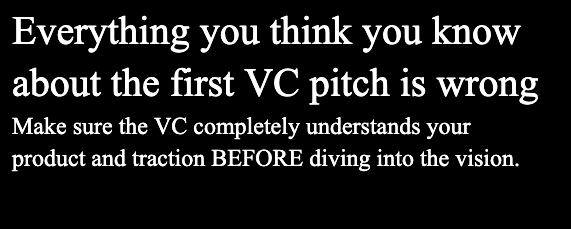Everything you think you know about your first VC pitch is wrong
How to Pitch your company when raising Seed or Series A
TLDR: your product is the most important thing.
Don’t lead with the market or the problem or your background or ANYTHING high-level.
The Product is the MAIN THING
lead with a super quick understanding of what the product is.
I can’t tell you how many pitches I’ve gotten where I still have no idea what the product is … even after 20 minutes.
In the early days, the product is the MOST important thing your company has accomplished. So discuss it. Show it. Lead with it. And do it up front.
the VC needs a CLEAR understanding of the product in the first 2 minutes. Feel free to do a quick demo.
and not all products are demoable. that’s ok. the most important thing is that you clearly explain the product and that the VC understands what it is.
DO NOT go to the next step of the presentation until the person you are talking with understands the product. Sometimes they will understand it even before the meeting (like they use your product already) – that’s the best case. Sometimes they will come in with a misconception. Sometimes they will just show up to a zoom meeting with no preparation at all.
Next: After they understand the product … talk about TRACTION.
This is the point where you talk about how things are going.
Have revenues? Customers? Partners? Employees? Integrations? Reached an amazing technical milestone? Built the product in less than 2 months while eating ramen and tuna fish? Raised money? Great founder resume?
This is the point where you show the VC you are a super founder that needs to be taken seriously.
Discuss the background of your co-founders.
“We went from zero to $100k ARR in the last two months”
“We just signed Citadel as a customer yesterday and are doing a pilot with Goldman Sachs”
“Founders Fund seeded us with $4 million”
“I built this same product within Microsoft”
“All three cofounders met in the finals of the math olympiad”
Get the VC leaning in. they should be impressed with what you have done to date. Of course, the longer you have been in business and the more money you have raised, the more accomplishments you will need to impress those pesky VCs.
Only after you properly explain the Product and get them excited about Traction should you proceed to the next step. But you should be able to do both of these things in the first 7 minutes.
Then comes the vision.
show them the future. You let them in on a secret. show them a world they have not considered before (or help them reconsider a world that they have discounted in the past).
get them on your side in your conspiracy.
They are ready for the vision because they know you are clearly a serious founder – you built a cool product with acceptable traction.
Most founders make the mistake of leading with the vision before the VC is ready to hear it. VCs can only understand the vision after first understanding the product and the traction.
Then comes the market.
If wasn’t clear in the vision section, explain the market and why it is a big market.
You’re in teaching mode, not in sell mode. You want them to understand the market – not yet convince them why you are gonna win. This is about education so they can come with a prepared mind.
Then address objections.
Bring up objections and good reasons to NOT invest in you. Address them one by one. You do not need to have answers to all of them but important to put them on the table and let the VC know that you’ve thought through them. You do not want the VC to ask you a gotcha question later.
Help them understand.
And … it is a wrap. you need to get this done in under 15 minutes (the faster, the better). The ONLY way to do that is to practice, practice, practice. And you will need to practice with people that DON’T know your product or your market. You need to practice with people that have similar backgrounds to the VCs you are pitching.
Leave plenty of time for the VC to ask you questions.
When a VC asks you a question, try to answer it quickly. Ideally in under a minute. If it takes you over a minute to answer a question, it better be an AMAZING answer. You get super penalized for rambling or wasting the VC’s time.
Ask them questions. This is not a one-way interview. You need to understand if this VC would be a good partner. Ask them a specific question based on their background or what they have invested in. the best questions are about YOUR business – like a business or GTM dilemma you are grappling with.
“We are choosing between two candidates to run revenues - sho do you think is better?”
“Most of our customers pay monthly. Should we push them to go annual? What is the best way to do that?”
“A former cofounder owns 10% equity and is no longer adding value. How should we deal with this?
“I have not gotten a raise or a new equity grant in 4 years. What do you think would be a fair compensation for me?”
“Greylock just gave me an exploding term sheet that expires tonight. How would you advise me to react to that?”
Remember to MANAGE the clock.
Usually you have 25 minutes for the first meeting. Your presentation should be no longer than 15 minutes. Understand the time and manage it.
You want to be able to wrap up the meeting well. Meetings that end with “oh no, I have to go, i have another meeting that starts right now” all suck. You need 2-3 minutes at the end to discuss next steps, timelines, and more. Remember, you are managing a sales pipeline. You need to understand how interested they are, build the timeline, and move them to the next step of the funnel.
Summary:
Start with a clear review of the product
Next, talk traction
Than the vision followed by the market
Leave time for the VC’s questions - answer them succinctly
Ask specific questions to the VC about your business
And manage the clock
Good luck!
special thank you to Rajal Patel, Bobby Samuels, and Travis May







Super helpful, Auren. I'd love to hear you think out loud about ways that nonprofit organizations, research centers, and movement builders can adapt this model.
Loved this, lots of parallels to pitching TV - get in, get out, explain it quickly, no rambles. Usually you *are* the product to some extent so personal story comes first but otherwise, surprisingly similar!